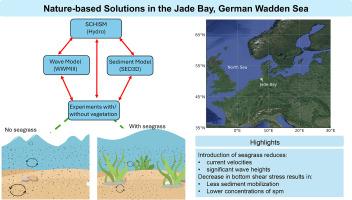Nature-based solutions: leveraging the coastal protective potential of seagrass in the Jade Bay region
引用次数: 0
Abstract
This study assesses the potential of seagrass meadows as a Nature-based Solution (NbS) to mitigate coastal risks in two locations within the southern German Wadden Sea: Jade Bay and the Outer Weser estuary. Using the unstructured-grid model framework SCHISM (Semi-implicit Cross-scale Hydroscience Integrated System Model), coupled with wind wave and sediment transport modules, we simulated hydrodynamic processes over a two-year period (2019–2020), with a focus on the impact of an extreme weather event. We examined the hydrodynamic, wave, and sediment effects of seagrass presence versus absence under both typical and storm conditions and evaluated two restoration site scenarios. The results demonstrate that seagrass can substantially attenuate wave heights (up to 40 %) and bed shear stress (up to 70 %). Risk mapping further indicates that seagrass consistently reduces areas classified as high erosion risk and delays the onset of sediment resuspension during storms. These findings emphasize the protective function of seagrass and support its broader application as a scalable and adaptive strategy for enhancing coastal resilience under climate-driven pressures.

基于自然的解决方案:利用玉湾地区海草的海岸保护潜力
本研究评估了海草草甸作为一种基于自然的解决方案(NbS)的潜力,以减轻德国南部瓦登海的两个地点:玉湾和外威西河口的沿海风险。利用非结构网格模型框架SCHISM(半隐式跨尺度水文科学集成系统模型),结合风浪和泥沙输运模块,模拟了两年(2019-2020年)的水动力过程,重点研究了极端天气事件的影响。我们研究了在典型和风暴条件下海草存在与不存在对水动力、波浪和沉积物的影响,并评估了两种恢复地点的情景。结果表明,海草对波高(衰减40%)和河床剪应力(衰减70%)有显著的抑制作用。风险地图进一步表明,海草持续减少被列为高侵蚀风险的地区,并延迟风暴期间沉积物再悬浮的开始。这些发现强调了海草的保护功能,并支持其作为一种可扩展和适应性策略的更广泛应用,以增强气候驱动压力下的沿海恢复力。
本文章由计算机程序翻译,如有差异,请以英文原文为准。
求助全文
约1分钟内获得全文
求助全文

 求助内容:
求助内容: 应助结果提醒方式:
应助结果提醒方式:


